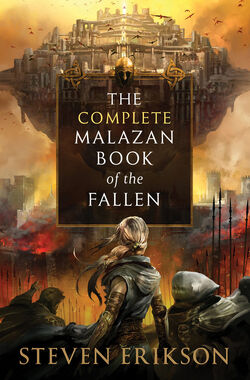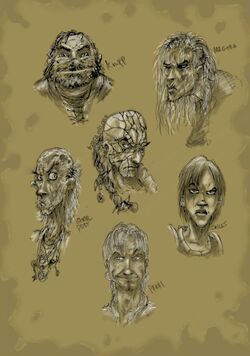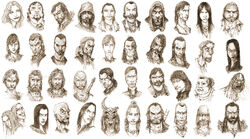
Tor e-book cover

Interpretation of some characters from the Malazan Book of the Fallen by Slaine69
See also: Spoiler free New Readers Zone
The Malazan Book of the Fallen [Ma-laa-zan][1] is an epic fantasy series written by Canadian author Steven Erikson. The series depicts a period of turmoil in the history of the Malazan Empire and the other nations that share its world, such as Lether. The series incorporates a vast number of characters (human, immortal and non-human), storylines, subplots, themes and locations. Unlike most fantasy series, which depict one large story divided into lesser volumes, the Malazan sequence mostly consists of single novels with their own self-contained storylines with only subplots and some characters continuing between volumes. The closest thing to a main storyline in the books follows the machinations of an alien deity called the Crippled God, which has been imprisoned upon the Malazan world and seeks to escape.
Novels and novellas
By Steven Erikson
Malazan Book of the Fallen

Interpretation of characters from the Malazan Book of the Fallen by slaine69

Sketch ideas for characters from the Malazan Book of the Fallen by Jeanfverreault
- Gardens of the Moon (1999)
- Deadhouse Gates (2000)
- Memories of Ice (2001)
- House of Chains (2002)
- Midnight Tides (2004)
- The Bonehunters (2006)
- Reaper's Gale (2007)
- Toll the Hounds (2008)
- Dust of Dreams (2009)
- The Crippled God (2011)
Bauchelain & Korbal Broach
- Blood Follows (2002)
- The Healthy Dead (2004)
- The Lees of Laughter's End (2007)
- Crack'd Pot Trail (2009)
- The Wurms of Blearmouth (2012)
- The Fiends of Nightmaria (2016)
The Kharkanas Trilogy
- Forge of Darkness (2012)
- Fall of Light (2016)
- Walk in Shadow (tbc)
The Witness Trilogy
- The God is Not Willing (2019)
By Ian C. Esslemont
Novels of the Malazan Empire
- Night of Knives (2005)
- Return of the Crimson Guard (2008)
- Stonewielder (2010)
- Orb Sceptre Throne (2012)
- Blood and Bone (2012)
- Assail (2014)
Path of Ascendancy
- Dancer's Lament (2016)
- Deadhouse Landing (2017)
- Kellanved's Reach (2019)
Series epigraph
Published in Gardens of the Moon:
Now these ashes have grown cold, we open the old book.
These oil stained pages recount the tales of the Fallen,
a frayed empire, words without warmth. The hearth
has ebbed, its gleam and life's sparks are but memories
against dimming eyes - what cast my mind, what hue my
thoughts as I open The Book of the Fallen
and breathe deep the scent of history?
Listen then, to these words carried on that breath.
These tales are the tales of us all, again yet again.
We are history relived and that is all, without end that is all.
Background
The Malazan world was originally created by Erikson and Esslemont in 1982 as a backdrop for a role-playing game using a modified version of the Dungeons & Dragons and GURPS rule sets.[2] By 1986 the Malazan world had developed to a world approaching that found in the novels.
At this point Erikson and Esslemont developed a movie script titled Gardens of the Moon, which was to play on the interactions of the patrons of a drinking establishment in the fictional city of Darujhistan. The script failed to be picked up and the authors agreed to write novels instead. Erikson developed Gardens of the Moon into a novel around 1991–1992, though it was not published until 1999, when Transworld Books picked up the series in the United Kingdom after a fierce bidding war. During discussions with Transworld, Erikson developed his plans for the series into a story arc comprising ten novels. Tor Books began publishing the series in the USA in 2004.
Esslemont, meanwhile, had written two Malazan novels in the late 1980s: Night of Knives and Return of the Crimson Guard. A revised and edited version of Night of Knives was published in 2005 as a special limited edition by PS Publishing, with Transworld picking up both books in 2007 for mass-market publication. Esslemont's initial deal with Transworld provided for six novels in total.
Erikson has stated that after the last novel of the Malazan Book of the Fallen was finished, he and Esslemont would write a comprehensive guide tentatively named The Encyclopaedia Malazica. In an interview, Erikson indicated that he had maps, notes, scribblings, etc. such as those that J. R. R. Tolkien's The Silmarillion was based on. However, they later revised this plan so that it would be written only after Esslemont had completed his initial six-volume deal with Transworld.
After concluding the main series, Erikson announced that he would be writing six further novels in the same world, comprising both a prequel and sequel trilogy.
Plot lines
The Malazan Book of the Fallen
The Malazan series does not follow a linear plot, that is, the novels are not produced in a straight chronological fashion. Instead, the stories occur in a semi-linear fashion, often having a novel cover one area of the world at a specific time, while the next novel overlaps the same time frame but in a different area of the world.
The first novel, Gardens of the Moon, introduces the main players in the series. Plot lines include the struggle for power within the city of Darujhistan, the war on Genabackis, and the introduction of a new threat on Genabackis, the Pannion Domin.
The second novel, Deadhouse Gates, takes place on the Seven Cities subcontinent and follows the Whirlwind rebellion and the rise of Sha'ik, focusing on a fugitive march across the continent called the Chain of Dogs.
The third novel, Memories of Ice, takes place back on Genabackis and follows the uneasy alliance between the armies of warlord Caladan Brood and the imperial Onearm's Host against the Pannion Domin. Memories of Ice takes place during the same time as Deadhouse Gates.
The fourth Novel, House of Chains, occurs back in Seven Cities and follows the imperial Adjunct Tavore Paran in her quest to squash the Whirlwind rebellion started in Deadhouse Gates. This novel also follows the trials of Karsa Orlong, a Teblor warrior setting out across the world from their isolated enclave.
The fifth novel, Midnight Tides, follows the clash of the united Tiste Edur tribes and the Letherii Empire. This novel does not feature characters seen in previous novels (with the sole exception of Trull Sengar). It takes place several years before Gardens of the Moon.
The sixth novel, The Bonehunters, combines all of the previous strands and plots, with the armies converging on Seven Cities, and the Letherii setting out in search of warriors to battle their immortal emperor.
The seventh novel, Reaper's Gale, takes the Malazan armies to the Letherii homeland. It also covers the Awl struggle against the Letherii on another side of the continent.
The eighth novel, Toll the Hounds, revolves around the Tiste Andii of Black Coral and some of the main characters who have returned, or settled, in the city of Darujhistan.
The ninth novel, Dust of Dreams, revolves around the Bonehunters and their journey on their new, mysterious mission in the far-off sub-continent of Kolanse.
The tenth novel, The Crippled God, ties the various plots and armies together for the battle in the Kolanse sub-continent.
The Kharkanas Trilogy
The three volumes that comprise the Kharkanas Trilogy are set more than 300,000 years prior to the main series and depict the splintering of the Tiste into their three distinct sub-races, a crisis caused by the actions of Mother Dark and her consort Draconus, and the refusal of certain Tiste nobles to accept their relationship. This trilogy is notable for explaining many concepts and ideas left vague in the main series, such as the nature of the Elder Gods.
The Toblakai Trilogy
After the Kharkanas Trilogy is completed, Erikson plans a further three volumes which will be set after The Crippled God and will focus on Karsa Orlong and his long-held plan to bring about the fall of human civilization.
Bauchelain and Korbal Broach
These side-novellas depict the misadventures of the two titular necromancers and their long-suffering manservant, Emancipor Reese, who played a minor role in Memories of Ice. The novellas move about their timeline and that of the series and are notably lighter in tone and more focused than the main series.
Novels of the Malazan Empire
Esslemont's first novel, Night of Knives, is a prequel to the main series. It is set in Malaz City on the night of Kellanved and Dancer's disappearance and the Shadow Moon.
The second novel in this series, Return of the Crimson Guard, is set shortly after the events of The Bonehunters. Events in that novel have triggered a major civil war and rebellion in Quon Tali itself, threatening the stability of the Malazan Empire. During this civil war, the Crimson Guard invade Quon Tali, hoping to achieve their long-held goal of overthrowing the Empire.
The third novel, Stonewielder, is a direct sequel to Crimson Guard. It features the reunified Malazan Empire invading the continent of Korel to bring the lengthy military campaign there to a swift end.
The fourth novel, Orb Sceptre Throne, is a direct sequel to Toll the Hounds. It is mainly set in and around Darujhistan and the rise of the prophesied Tyrant.
The fifth novel, Blood and Bone, is set after Stonewielder and roughly simultaneously with the events of Orb Sceptre Throne and The Crippled God. It is set mainly on the continent of Jacuruku.
The sixth novel, Assail, is the final volume in this series and takes place after Blood and Bone and The Crippled God. It is set on the continent of the same name and resolves the story elements from Memories of Ice and the immediately preceding novels. According to both Esslemont and Erikson, it serves as a coda to the main Malazan series.
Path of Ascendancy
Esslemont's planned trilogy of prequel novels explores the beginnings of the Malazan Empire starting with Dancer's Lament.
Races
Main article: Races
There are a number of intelligent human, humanoid, and non-humanoid races in the Malazan world. References are made to races which walked the Malazan world hundreds of thousands of years prior to the events in the series.
A list of intelligent species is shown:
- Azathanai
- Barghast
- Eleint
- Eres
- Forkrul Assail
- Human
- Imass
- Jaghut
- Jhag
- Jheck
- Jheleck
- K'Chain Che'Malle
- K'Chain Nah'ruk
- Moranth
- Stormriders
- Thel Akai
- Thelomen Toblakai
- Tiste Andii
- Tiste Edur
- Tiste Liosan
- T'lan Imass
- Trell
Geography
The series takes place on a number of continents on a single planet, though scenes within the series often take place within the warrens, or other planes of existance. Midnight Tides confirms six continents on the planet, though the series does use the term "subcontinent" which makes it unclear of which landmasses are full continents, and which are subcontinents.
History
Erikson and Esslemont have created a world with a history of hundreds of thousands of years.
Imass Wars
The Imass Wars are frequently mentioned in the Malazan series. The Jaghut were generally a peaceful race, who believed in isolationism. However, a small number of Jaghut used their powerful magic to become Tyrants, enslaving entire populations. The Imass fought against the tyranny, waging a war of genocide on the Jaghut which lasted hundreds of thousands of years. The Imass underwent the Ritual of Tellann to claim immortality for the singular purpose of the genocide.
Coming of the Tiste
During this time the Tiste Edur and the Tiste Andii came to the world through their respective Warrens, waging war on the K'Chain Che'Malle. The Edur betrayed the Andii and wiped them out (with the exception of a small group of Andii that had arrived previously under Anomander Rake).
The Fall of the Crippled God
The High King Kallor forged an empire, encompassing the continents of Jacuruku and Korelri. His High mages rebelled due to his tyrannical rule and in a thirst for power, summoned down the Crippled God. The summoning went awry, which led to the near complete destruction of Jacuruku. The Crippled God was torn apart and fell to the earth in pieces. Fearing that the Elder Gods would punish him, Kallor destroyed his own empire. The Elder gods eventually cursed Kallor with immortality and the inability to ascend.
Founding of the Malazan Empire
A century before the beginning of Gardens of the Moon, two men named Kellanved and Dancer schemed and overthrew the lord of Malaz Island, forging the heart of the newborn Malazan Empire. Under the leadership of Kellanved, the empire spread across numerous continents, and waged war upon Seven Cities and Genabackis. The Malazan Empire's military power was increased dramatically when Kellanved discovered the First Throne, allowing him to control the T'lan Imass. Kellanved and Dancer disappeared for two years on an unknown mission and on their return were, supposedly, assassinated by their comrade Surly, who adopted the name Laseen and became the Empress of the Malazan Empire.
Under Laseen
Under the rule of Laseen, the Malazan Empire has continued its policy of expansion. However, many see the empire as being too overstretched. It is at this point that the series of events in Gardens of the Moon occur.
Magic
Magic within the Malazan series is accomplished by tapping the power of a Warren or Hold. Effects common from magic or enchantments are the magical investment of objects, energy projection, travel through Warrens, and the manipulation of the power or element of the Warren. In addition to this type of magic use, there is an ancient form of magic which involves the use of spirits, which predates both Warrens and holds. In the series, Erikson makes clear the progression of magic from its earliest forms:
The Wandering: This was a time which predated civilization and refers to the ancient magic of using spirits. This is demonstrated when the mage, Bottle, uses spirits and his mental capacity to inhabit animals minds and use basic but powerful magic. It is a time of chaotic energies where nothing is constant.
The construction of the Azath: When the Azath Houses were made, they drew power to themselves and acted like an anchor in chaos; keeping chaos at bay and allowing Holds to form. These holds are alternate worlds and can contain different species and different types of power. From the creation of the holds arose the possibility of the creation of gods, and so it stands that for each hold there is usually at least one ruling god. Later, these gods became known as the Elder Gods because of their great power. The holds and their gods form a pantheon known as the Cedance with the Errant as its master.
Warrens: When the Elder God K'rul bargained with the Eleint, he created a new source of power - using his body as a vessel - called warrens. These Warrens don't have the power of holds and their gods usually aren't as powerful. The gods of the Warrens are known as the Young Gods, as it was by the hand of an Elder God that they were created. Warrens don't tend to be inhabited, and not all Warrens necessarily have a God. The Warrens and the Gods therein form a pantheon called the Deck of Dragons. Ganoes Paran becomes Master of the Deck and thus a master of all the Warrens.
It becomes apparent in the last book that a new set of Warrens is created by Icarium Lifestealer using the Errant's eye as a source of power.
Characters
Adjunct Tavore and the Bonehunters
Tavore Paran is sister to Ganoes Paran and Felisin Paran. She succeeded Adjunct Lorn upon her death and was tasked with defeating the rebellion centred around the Whirlwind. The army she forged became known as the Bonehunters after the Siege of Y'Ghatan.
Throughout the novels, the character of Tavore remains a mystery and although it is apparent that she is extremely well informed and knowledgeable, it is never really made truly apparent why. Despite exile, she remains loyal to the Empress and the Empire of Malaz and refuses to give up her title as Adjunct.
Translation pages
For a list of character and location names in non-English publications see the following pages:
Trivia
In an interview with Tor, Erikson explained his thoughts behind the title for the series:
- "The title was inspired by Napoleon's Book of the Fallen; although that one simply lists the names of the fallen soldiers from his campaigns. I was more inspired by the notion of it than its actuality. Fallen soldiers is one thing, but fallen lives and the stories surrounding them is another — one need not die to fall, in that sense. So, while characters will fall to the wayside (die), others will survive the series."[3]
Notes and references
- ↑ Read for Pixels 2016 Interview As pronounced by Steven Erikson at 29:23
- ↑ https://web.archive.org/web/20141022225352/http://www.steven-erikson.com/index.php/the-world-of-the-malazan-empire-and-role-playing-games
- ↑ http://encyclopediamalazica.pbworks.com/w/page/18882453/TOR%20Q?A= See question 6
